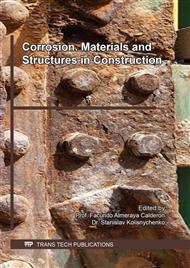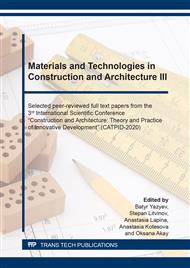[1]
El-Reedy M., Steel-reinforced concrete structures: assessment and repair of corrosion. Taylor & Francis Group, (2008).
Google Scholar
[2]
C. Alonso, C. Andrade, J. Rodriguez and J. M. Diez, Factors controlling cracking of concrete affected by reinforcement corrosion, Mater. Struct. 31 (1998) 435–441.
DOI: 10.1007/bf02480466
Google Scholar
[3]
V.Y. Lushnikova and A.G. Tamrazyan, The effect of reinforcement corrosion on the adhesion between reinforcement and concrete, Mag. Civ. Eng. 80 (4) (2018) 128–137.
Google Scholar
[4]
N.Z. Saatova, Dependencies to determine the measure of damage and calculation of residual life of reinforced concrete superstructure, exposed to salt corrosion, European science review, 9–10 (2016) 210–212.
Google Scholar
[5]
C. Sosdean, L. Marsavina and de Shutter G., Damage of Reinforced Concrete Structures due to Steel Corrosion, Adv. Mater. Res. 1111 (2015) 187–192.
DOI: 10.4028/www.scientific.net/amr.1111.187
Google Scholar
[6]
V.S. Ramachandran, Concrete Admixtures Handbook Properties, Science and technology Second Edition, William Andrew Publishing, (1996).
Google Scholar
[7]
ISO 8044:2020 Corrosion of metals and alloys — Vocabulary.
Google Scholar
[8]
Y.I. Kuznetsov, Progress in the science of corrosion inhibitors, Int. J. Corros. Scale Inhib. 4 (1) (2015) 15–34.
Google Scholar
[9]
C.G. Dariva and A.F. Galio, Corrosion inhibitors – Principles, mechanisms and applications, Developments in Corrosion Protection ed M Aliofkhazraei (InTech), 2014, p.365–380.
Google Scholar
[10]
S.A. Abdulsada, Corrosion inhibitors: Principles and application, LAP LAMBERT Academic Publishing, (2014).
Google Scholar
[11]
S. Ghaffari, M. Aliofkhazraei and A.S. Rouhaghdam, Corrosion Inhibition of Sodium Silicate and Piperazine and Their Synergistic Effect on Carbon Steel in Soft Water Media, Prot. Met. Phys. Chem. Surfaces. 55 (6) (2019) 1195–1206.
DOI: 10.1134/s2070205119060145
Google Scholar
[12]
S. Papavinasam, Corrosion Inhibitors Uhlig's Corrosion Handbook: Third Edition, Wiley, New Jersey, 2011, p.1089–1105.
Google Scholar
[13]
H. Justnes, Preventing Chloride Induced Rebar Corrosion by Anodic Inhibitors – Comparing Calcium Nitrate with Calcium Nitrite, Proc. of 29th Int. Conf. on Our World in Concrete & Structures (Singapore). 1 (2004) 45–58.
Google Scholar
[14]
A. Ahmad and A. Kumar, Comparative Behaviour of Nitrite and Nitrate for the Protection of Rebar Corrosion, J. Inst. Eng. Ser. D. 98 (2017) 177–187.
DOI: 10.1007/s40033-016-0125-9
Google Scholar
[15]
Z. Cao, M. Hibino and H. Goda, Effect of nitrite ions on steel corrosion induced by chloride or sulfate Ions, Int. J. Corros. (2013) 853730.
DOI: 10.1155/2013/853730
Google Scholar
[16]
O. Kozaderov, O. Kozaderova and S. Niftaliyev, Corrosion behavior of low carbon steel in technological aqueous calcium nitrate solutions, Int. J. Corros. Scale Inhib. 4 (3) (2015) 221–225.
DOI: 10.17675/2305-6894-2015-4-3-221-225
Google Scholar
[17]
B.P. Maliekkal, J.T. Kakkassery and V.R. Palayoor, Efficacies of sodium nitrite and sodium citrate–zinc acetate mixture to inhibit steel rebar corrosion in simulated concrete interstitial solution contaminated with NaCl, Int. J. Ind. Chem. 9 (2018) 105–114.
DOI: 10.1007/s40090-018-0142-7
Google Scholar
[18]
M. Finšgar and J. Jackson, Application of corrosion inhibitors for steels in acidic media for the oil and gas industry: A review, Corros. Sci. 86 (2014) 17–41.
DOI: 10.1016/j.corsci.2014.04.044
Google Scholar
[19]
S. Gowri, J. Sathiyabama and S. Rajendran, Corrosion inhibition effect of carbon steel in sea water by L-Arginine-Zn2+ system, Int. J. Chem. Eng. (2014) 607209.
DOI: 10.1155/2014/607209
Google Scholar
[20]
H-S. Lee, V. Saraswathy, Kwon S-J. and S. Karthick, Corrosion Inhibitors for Reinforced Concrete: A Review Corrosion Inhibitors, Principles and Recent Applications ed M Aliofkhazraei, IntechOpen, 2018, p.95–120.
DOI: 10.5772/intechopen.72572
Google Scholar
[21]
N. Bouzeghaia, A. Mihi, A. Aït-Mokhtar and M. Naoun, Effect of passivation on chloride concentration threshold of steel reinforcement corrosion, Anti-Corrosion Methods Mater. 65 (6) (2017) 588–598.
DOI: 10.1108/acmm-12-2016-1741
Google Scholar
[22]
E. Velichko and L. Talipov Theoretical and practical aspects of improving the durability of steel reinforcement in transport designs, using passivation and plasticizing chemical additives, IOP Conference Series: Earth and Environmental Science. 90 (1) (2017) 012202.
DOI: 10.1088/1755-1315/90/1/012202
Google Scholar



